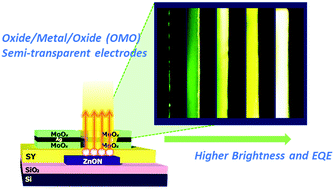Light-emitting transistors (LETs) have recently emerged as a promising type of optoelectronic device which incorporates the switching function of a transistor with a light-emitting function. Zinc oxynitride (ZnON) based organic–inorganic hybrid LETs (HLETs) have recently shown excellent characteristics in this context, including very low threshold voltage (<5 V), high mobility (up to 5.3 cm2 V−1 s−1) and brightness of 1.64 × 104 cd m−2, a significant improvement compared to organic based LETs. Despite remarkably improved performance, the external quantum efficiency (EQE) of HLETs was ∼0.1%, leaving room for additional improvement. To overcome the low EQEs of HLETs, we have investigated the electrical and optical characteristics of HLETs incorporating MoOx/Ag/MoOx semi-transparent electrodes with variable Ag layer thickness. HLETs with the architecture MoOx/Ag/MoOx (8/15/15 nm) exhibited an electron mobility of 1.06 cm2 V−1 s−1 with on/off ratio of 1.05 × 104, a maximum brightness of 2.09 × 104 cd m−2 and a greatly improved EQE of up to 3.31%. This study provides valuable information about the electrical and optical properties of HLETs with oxide/metal/oxide (OMO) semi-transparent electrodes and contributes towards a comprehensive understanding of the optoelectronic behavior of LETs.
